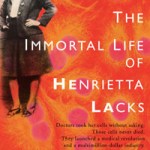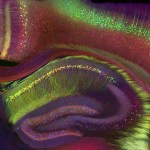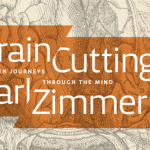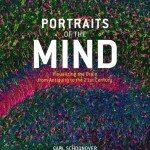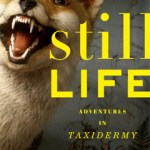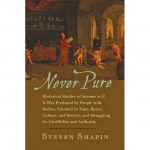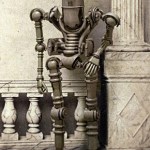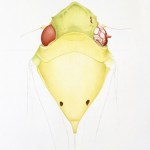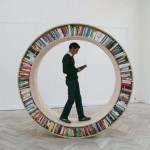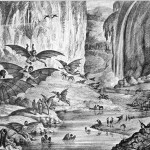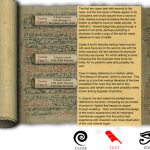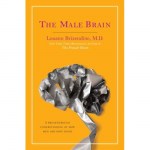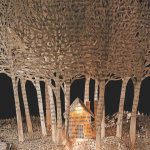Books & Essays
The Wellcome Trust book prize honors books that "bring together the worlds of medicine and literature."
This year's recipient was none other than Rebecca Skloot's The Immortal Life of Henrietta Lacks - a well-deserved win for a nuanced exploration of the tensions between pure research, medical ethics, and social injustice (with a meta-message about the role of the science journalist in telling these kinds of stories).
Some of the other books on the Wellcome shortlist were new to me, so I wanted to highlight them in case you're interested in some holiday reading. But I'll be honest, this…
Just in: Carl Schoonover's Portraits of the Mind, which I reviewed a few weeks ago, gets the New York Times Science section treatment. Check out their video interview with Carl; his account of the book's genesis illustrates the benefits that accrue when scientists take the opportunity to share the things that excite them about their work with nonscientists. And congratulations to Carl for all the well-deserved attention!
Today's Guardian has a very interesting (though long) article by Richard Holmes, author of The Age of Wonder, about the unsung women of science. In the Guardian piece, Holmes shares some of his research for his forthcoming book, The Lost Women of Victorian Science:
[M]y re-examination of the Royal Society archives during this 350th birthday year has thrown new and unexpected light on the lost women of science. I have tracked down a series of letters, documents and rare publications that begin to fit together to suggest a very different network of support and understanding between the sexes.…
In less than a month (December 2nd), Christie's will auction off Edward Tufte's library - an idiosyncratic collection of first edition books, plates, prints, and ephemera that the dataviz guru calls his "Museum of Cognitive Art," and I call "Jessica's Christmas List."
I'm not going to sample low-rez images of the lots here, because there's a stunning slideshow, complete with curation, at the Christie's website. If you've got ten minutes, this is virtual antiquarian dataviz windowshopping at its best.
There appear to be 160 lots; Tufte's website describes it as "200 rare books, including major…
Hippocampus: Broad Overview
Tamily Weissman, Jeff Lichtman, and Joshua Sanes, 2005
from Portraits of the Mind: Visualizing the Brain from Antiquity to the 21st Century by Carl Schoonover
The first time I created a transgenic neuron, it was in a worm, C. elegans -- a tiny, transparent cousin of the earthworm. I injected DNA into the embryonic worm, let it grow up, and voila: there was one eerie green blotch like a little Pac-Man ghost, its long green axon a lime racing stripe running along the worm's transparent body. The worm wiggled, but I was the one hooked: science is beautiful.
You…
Have e-books killed tree-books? I hope not - I love hefting a brand-new book in my hand and letting the pages fan open. It's sensual and anticipation-laden, like opening a bottle of good wine. But perhaps science writer and blogger Carl Zimmer is hedging his bets on the future of paper books: he's released his latest collection, Brain Cuttings, exclusively for Kindle, iPad, and other mobile devices. I clicked over to read an excerpt, and this was the first passage I saw:
Let's say you transfer your mind into a computer--not all at once but gradually, having electrodes inserted into your…
This, this and this all came close, but in the end, it took a book: a yummy new neuroscience, history of science, beauty of science, wow-brains-are-beautiful book.
The other day I heard about something that I just HAD to blog, hiatus/retirement be damned! Portraits of the Mind: Visualizing the Brain from Antiquity to the 21st Century, a new book by neurobiology PhD candidate Carl Schoonover, is coming out in a few weeks, and I'm lucky enough to have a preview copy sitting here before me.
This book encapsulates my original vision for BioE - a narrative that brings science history together…
Edge.org has invited comments on Craig Venter's synthetic bacterium from thinkers like Freeman Dyson, George Dyson, and our very own PZ Myers. Nassim Taleb is particularly pessimistic:
If I understand this well, to the creationists, this should be an insult to God; but, further, to the evolutionist, this is certainly an insult to evolution. And to the risk manager/probabilist, like myself & my peers, this is an insult to human Prudence, the beginning of the mother-of-all exposure to Black Swans. Let me explain.
Evolution (in complex systems) proceeds by undirected, convex bricolage or…
Here's another interesting summer reading prospect for BioE-philes: Still Life: Adventures in Taxidermy by Melissa Milgrom. From the New York Times review:
The best chapter in "Still Life" by far is the one in which Ms. Milgrom visits with the fascinating and foul-mouthed British artist Emily Mayer, the woman who is Mr. Hirst's taxidermist. She's the woman who, we learn, "repairs the sharks, preserves the grizzlies, assembles the skeletons, and casts the cow heads for his multimillion-dollar artworks." Ms. Mayer is a Tim Burtonesque perfectionist: "I can't have a piece for Damien discolor in…
Never Pure: Historical Studies of Science as if It Was Produced by People with Bodies, Situated in Time, Space, Culture, and Society, and Struggling for Credibility and Authority: this could be awesome, or very very bad. I can't wait to find out.
From Mechanical Brides of the Uncanny by Edward Bateman
In "Mechanical Brides of the Uncanny," artist Edward Bateman creates images that explore photography's role as historical evidence. Presented as a collection of discovered carte de visites, this book documents a forgotten age of mechanical wonders. Carte de visites were an immensely popular form of photography in the last half of the nineteenth century. They were widely traded and collected, with subjects ranging from portraits of everyday people to those of luminaries. Bateman uses this history to question the idea that all…
Cornelia Hesse-Honegger's beautiful book Heteroptera is one of my most treasured natural illustration collections. Unfortunately, it seems to be out of print now, but Wired recently compiled a gallery of her work, and I highly recommend a visit.
The subtle and not-so-subtle asymmetries on Hesse-Honegger's specimens, like the cyst-eyed cicada above, are latently sinister: these are insects collected near Three Mile Island, Chernobyl, nuclear plants, and sites downwind of nuclear test grounds. Are the defects Hesse-Honegger catalogs a telltale sign of environmental contamination? Or is she…
I ran across first one, then two articles on the scientific benefits of failure in the past few weeks: this one by Jonah Lehrer for Wired (originally out in December), and this one by W. Barksdale Maynard for the April issue of the Princeton Alumni Weekly. Odd - or maybe not so odd; with the economy crashing down, oil rigs blowing up, etc., it's awfully reassuring to reflect on the good side of screwups.
Lehrer's piece begins by debunking an overly romantic and simplistic view of science, in which experiments come out the way you expect (ha):
Dunbar came away from his in vivo studies with an…
So much to read this week! Here are a couple of quick links of interest:
Carl Zimmer on comparing the E. coli genome to Linux code:
A number of scientists have begun to compare natural and manmade networks. A lot of the same rules appear to be at work in the growth of the Internet, airport connections, brain wiring, ecosystem food webs, and gene networks. But very often, scientists are finding, it's the differences between natural and manmade networks that are most revealing, offering clues to the different ways in which people and evolution build complex things.
And the NYT Magazine has an…
I have no idea of the source on this one - anybody know who made it? This artist has created a similar model, but the inside's padded as seating, so it probably wouldn't work as well as a human hamster wheel.
Via
I perversely love attending conferences where traditional journalists complain that bloggers are evil. :) Yesterday I heard that line again (in jest, relax) at a great discussion about changing media practices and the legal implications of various forms of content reuse, sponsored by the Online Media Legal Network. But the focus was a little bit different: are "new media" practices really that new? Historians know that almost two centuries ago, rival newspapers reprinted one another's content freely - often with snarky commentary, and nary a licensing fee or permission. Fact-checking fell by…
A very cool addition to the NLM "Turning the Pages" virtual library, which I blogged about back in December: the Edwin Smith surgical papyrus. You literally click and drag to unroll the papyrus, and then toggle the annotations on or off. While it doesn't have the pretty pictures that some of their other virtual manuscripts do (like Robert Hooke's Micrographia), it's pretty cool to unroll the world's oldest surviving surgical text, written in Egyptian script circa the 17th century BC.
(Alas, while my first instinct was "This would look so cool on the iPad," the website's in flash. Boo.)
So the word among my friends is that the iPad, which, as Stephen Fry noted, may be the closest thing humanity has yet produced to a Hitchhiker's Guide to the Galaxy, might just be worth buying -- if only as a stunningly cool toy and not, alas, the tablet many of us wanted. For example, I give you TouchPress' ebook The Elements for iPad, by Theodore Grey:
As the first really new ebook developed from the ground up for iPad, The Elements beautifully shows off the capabilities of this lovely device. It is impossile to describe in words the experience of seeing and almost feeling over 500…
Women have white matter, men have duct tape. Or so implies Louann Brizendine's latest book, the Male Brain, dissected in this post and comments at Language Log:
You may remember the controversy surrounding her previous book, the Female Brain, which (in the UK edition) depicted women's cerebrums as overstuffed, exploding purses. So for men, this is actually a step up. (Maybe men and women can cooperate and they can duct tape our brain shut? Wait. . . that doesn't sound good.)
I can't wait to get a copy of Jason Thompson's brand-new project, Playing with Books: The Art of Upcycling, Deconstructing, and Reimagining the Book. Thompson, the founder and creative director of Rag and Bone Bindery, has long kept a blog featuring the best book and paper artists. Now he's edited a book art book, and it looks great. I mean, it has a section on "shaping books with power tools" - what more do you need??
Playing with Books: The Art of Upcycling, Deconstructing, and Reimagining the Book at Amazon
